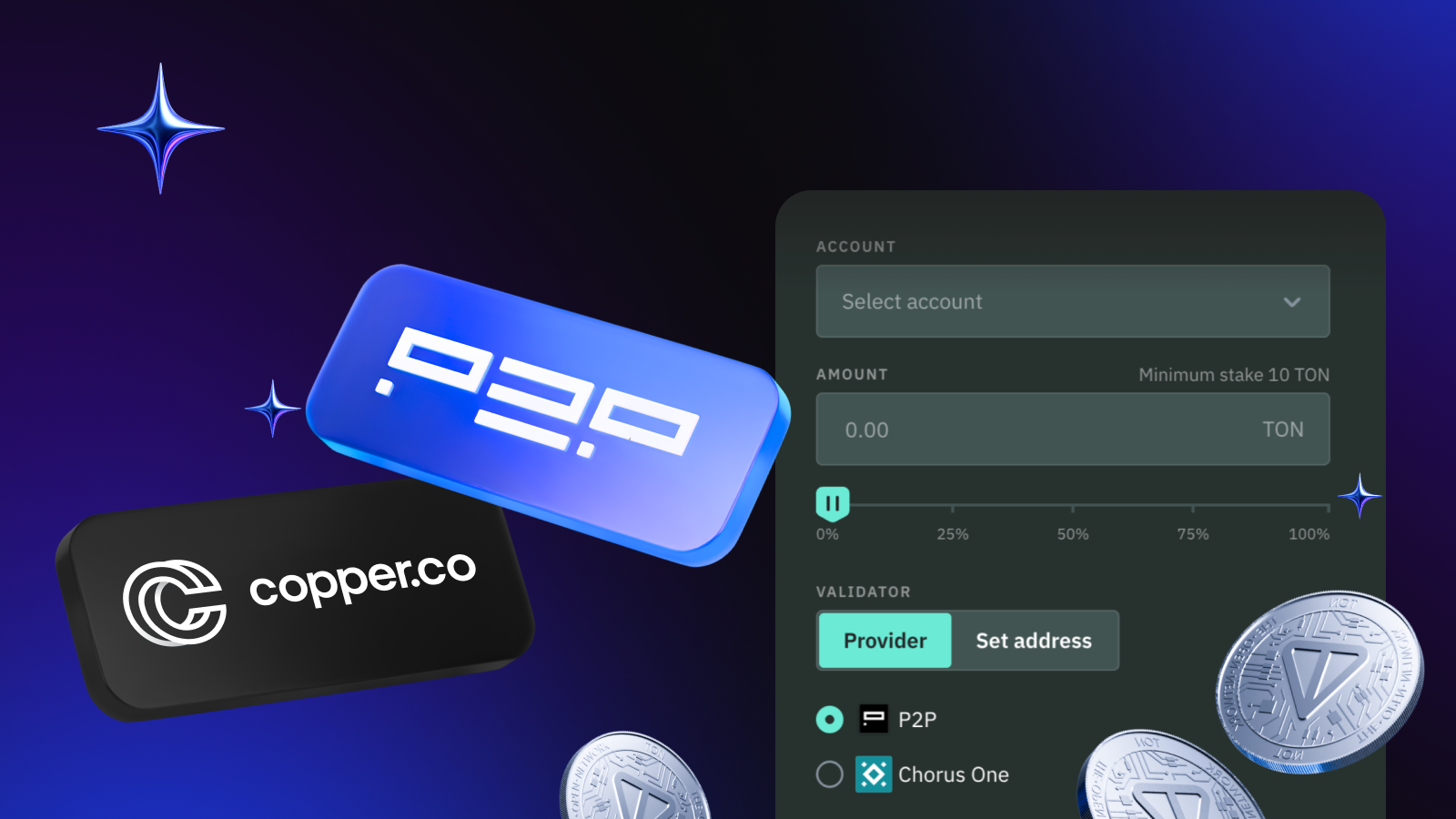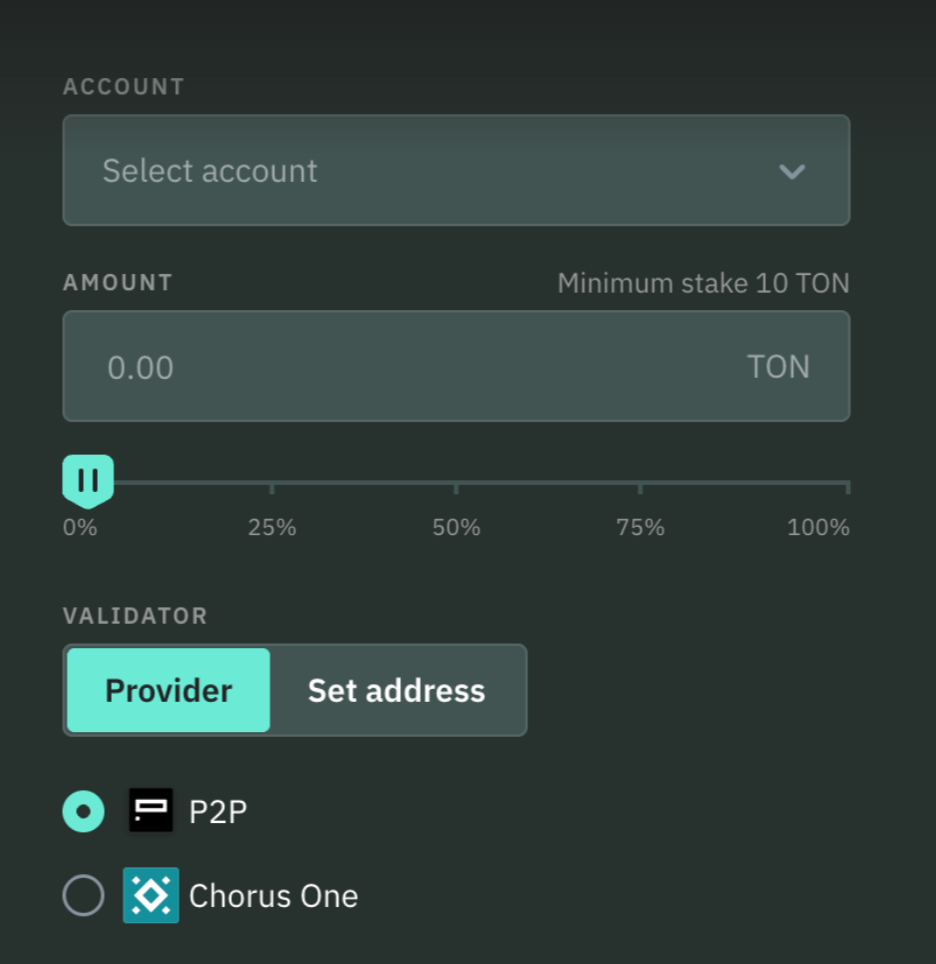Subscribe to P2P-economy
Stay up to date! Get all the latest & greatest posts delivered straight to your inbox
Subscribe
Institutions don't settle for single-vendor solutions. They demand choice, competitive options, and the ability to distribute risk across best-in-class providers.
Copper's integration of P2P.org as TON staking provider delivers exactly that — giving clients the flexibility to select infrastructure partners based on performance, relationship, and strategic fit rather than platform limitations.
Copper's integration delivers exactly that: multiple validator options, transparent selection criteria, and zero compromise on security or user experience.
The Open Network operates differently than most proof-of-stake chains. Validator elections run in alternating "even" and "odd" rounds, requiring strategic infrastructure deployment to maximize participation and uptime.
P2P.org solves this through dual validator contracts — one dedicated to even rounds, one to odd rounds. The result? Clients can split their stake across both pools to ensure maximum validator participation and rewards capture.
P2P.org's infrastructure is designed specifically for TON's validator economics. Copper clients now get direct access to that expertise without leaving custody.

This integration reinforces a fundamental shift in institutional crypto infrastructure: custody platforms are becoming validator marketplaces.
Clients want the ability to choose providers based on performance data, strategic relationships, and competitive positioning. Single-provider integrations create vendor lock-in. Multi-provider platforms create optionality.
P2P.org's addition as Copper's second TON provider proves the model works. Institutions can now distribute stake across validators, benchmark performance, and optimize rewards strategies without sacrificing custodial security or operational simplicity.
For treasury managers: You get validator choice without custody complexity.
For compliance teams: All staking happens within Copper's SOC 2 Type I certified environment.
For finance operations: Reward tracking, reporting, and tax documentation remain unified under Copper's institutional-grade reporting infrastructure.
P2P.org brings the same validator reliability that powers their institutional client base to Copper's TON integration:
Copper clients now access that infrastructure directly. Assets remain in Copper's custody environment while P2P.org handles validator operations, eliminating third-party custody risk and operational overhead.
TON staking via P2P.org is live now on Copper's platform.
If you're a Copper client, log in to your dashboard and select P2P.org as your TON staking provider. If you're exploring institutional custody with staking capabilities, connect with Copper's team to learn how multi-provider integrations deliver better outcomes.
The future of institutional staking is choice, transparency, and infrastructure optionality — all delivered through the custody platforms you already trust.
<p></p><h2 id="at-a-glance"><strong>At a Glance:</strong></h2><ul><li><strong>Bron launched ETH and Solana staking in weeks</strong> using P2P.org's Unified API — one integration, multiple networks, zero infrastructure overhead.</li><li><strong>MPC security meets staking revenue:</strong> Bron users get institutional-grade protection linked to Copper with features like seedless recovery, hidden vaults, and inheritance controls — all while earning staking rewards directly in-wallet.</li><li><strong>Powered by $10B+ validator infrastructure:</strong> The same P2P.org network securing assets for 100+ institutional clients now enables seamless, non-custodial staking inside Bron's wallet interface.</li><li><strong>Unified API in action:</strong> This integration proves how fast wallets and custodians can add multi-chain staking without running validators, managing rewards, or compromising security.</li></ul><p>Institutional-grade staking infrastructure just became exponentially more accessible. </p><p>Bron's integration of P2P.org's Unified API delivers native ETH and Solana staking through enterprise-level MPC security — proving that institutional custody and seamless user experience aren't mutually exclusive.</p><h2 id="a-new-chapter-for-wallet-staking"><strong>A New Chapter for Wallet Staking</strong></h2><p>Users expect staking to work like every other wallet feature — seamless, secure, and native to the interface. But most wallets face a brutal choice: build and maintain expensive validator infrastructure across multiple networks, or skip staking entirely and leave revenue on the table.</p><p>Bron’s team wanted to bring staking to its users in a way that was both seamless and secure. With P2P.org’s Unified API, they found a way to do exactly that, without building any infrastructure in-house.</p><h2 id="the-integration"><strong>The Integration</strong></h2><p>The integration connects Bron’s wallet interface directly to P2P.org’s Unified API, allowing users to delegate ETH and SOL in just a few clicks. The entire flow happens inside the wallet’s native UI:Users choose an asset, confirm the transaction through their MPC-secured keys, and track rewards in real time.</p><p>Under the hood, P2P.org’s Unified API handles all staking operations — validator management, network interactions, and reward distribution — while Bron retains complete control over the user experience and key security.</p><p>This collaboration brings the best of both worlds together: Bron’s MPC (multi-party computation) security linked to Copper’s infrastructure, and P2P.org’s proven validator network securing over $10B in assets across 40+ blockchains.</p><p><strong>This is institutional-grade staking infrastructure made instantly accessible.</strong></p><h2 id="security-architecture-that-doesnt-compromise"><strong>Security Architecture That Doesn't Compromise</strong></h2><p>Bron's wallet is purpose-built for institutional use cases, and the staking integration preserves every security guarantee. Its architecture is built around security and recoverability — a key reason this integration stands out. The wallet uses MPC technology to eliminate single points of failure: private keys are divided into multiple encrypted shards, and no single party ever has full access.</p><p>Bron extends this foundation with features specifically designed for institutional asset management:</p><ul><li><strong>Seedless recovery mechanisms</strong> that enable account restoration without vulnerable seed phrases</li><li><strong>Hidden vaults</strong> for privacy-critical holdings</li><li><strong>Inheritance controls</strong> for long-term wealth transfer planning</li><li><strong>Policy engine</strong> supporting multi-signature approvals and role-based access controls</li></ul><p>With these protections in place, staking through Bron is fully non-custodial.Users maintain complete control of their assets, while P2P.org provides validator reliability, slashing protection, and uptime guarantees through the Unified API.</p><h2 id="scaling-staking-through-unified-api"><strong>Scaling Staking Through Unified API</strong></h2><p>For wallets, custodians, and fintech platforms, the Bron integration demonstrates what’s now possible with P2P.org’s Unified API.A single integration unlocks staking across multiple chains, removing the need for protocol-specific SDKs, custom logic, or validator infrastructure.</p><p>By connecting once, Bron immediately enabled two networks — Ethereum and Solana — and can add new ones as P2P.org expands coverage. The same API layer also handles performance tracking and reward reporting, simplifying both the developer experience and operational overhead.</p><p>This modular approach lets wallets focus on what they do best — designing user experiences — while P2P.org handles everything under the hood.</p><h2 id="built-on-trust"><strong>Built on Trust</strong></h2><p>Both teams share a vision for the next generation of wallet infrastructure: combining security, compliance, and user autonomy with best-in-class network infrastructure.</p><p>Bron brings advanced key management, recovery, and policy tools that make digital asset ownership more resilient. P2P.org provides the staking foundation trusted by some of the largest institutions and networks in the industry.</p><p>Together, we’re setting a new standard for how wallets integrate staking — secure by design, production-ready, and infinitely scalable.</p><h2 id="for-wallets-and-platforms"><strong>For Wallets and Platforms</strong></h2><p>Unified API is now live and available for new integrations.Wallets, custodians, and exchanges can implement staking-as-a-feature through the same endpoints that power Bron’s integration — bringing institutional-grade staking to their users in weeks, not months.</p><p>If you’re building a wallet or custody product and want to integrate staking through P2P.org’s Unified API, reach out to our API team.</p><p>Let’s build the next generation of staking together.</p><div class="kg-card kg-button-card kg-align-center"><a href="https://link.p2p.org/bdteam?ref=p2p.org" class="kg-btn kg-btn-accent">Book a Unified API Demo</a></div>
from p2p validator